Gone with the Wind (Victor Fleming, 1939) is eighty years after its release still one of the most brilliant and captivating Hollywood films. It's a grand epic, more than four hours long, about the times of American Civil War and how it affected a group of Southern landed gentry. If you account for inflation, Gone with the Wind is probably the highest-grossing film ever released. Stars are the indomitable Vivien Leigh as Scarlett O'Hara, the oldest daughter and presumed heir of the Tara plantation, and Clark Gable as Rhett Butler, her on and off romantic interest and rival.
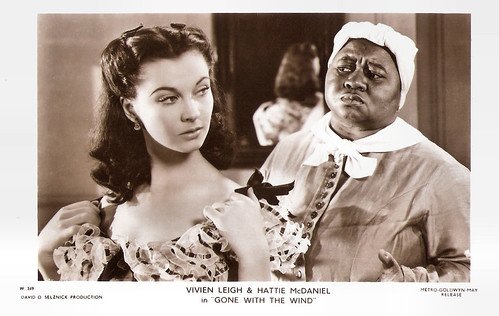
British postcard in the Picturegoer Series, London, no. W. 349. Photo: David O'Selznick Production / Metro-Goldwyn-Mayer. Publicity still for Gone with the Wind (Victor Fleming, 1939) with Vivien Leigh and Hattie McDaniel.

Italian postcard by Zincografica, Firenze. Photo: publicity still for Gone with the Wind (Victor Fleming, 1939) with Clark Gable and Vivien Leigh.

Dutch postcard by Filmfreak Productions / Painted Movies, no. FA 386. Illustration by Renato Casaro for Gone with the Wind (Victor Fleming, 1939).
Gone with the Wind (1939) brought together the best people in Hollywood. The end result is a stunning film, which remains remarkably faithful to Margaret Mitchell's novel about the South, before and after the Civil War. The vision of David O. Selznick, the power behind bringing the novel to the screen, pays off handsomely. Credit must also be given to the director, Victor Fleming, and his vision, as well as the adaptation by Sydney Howard, who gave the right tone to the film. The gorgeous cinematography created by Ernest Haller gives us a vision of the gentle South before the war, and the Phoenix raising from the ashes of a burned Atlanta. The music of Max Steiner puts the right touch behind all that is seen in the film.
Crucial for the success of Gone with the Wind (1939) was the casting of British Vivien Leigh as southern belle Scarlett. Her beauty, her sense of timing, her intelligent approach to this role, makes this a hallmark performance. Leigh created an unforgettable, multi-layered character. Scarlett is not a pleasant person, not at all. she can be whiny, needy and mousy. She's also scheming, manipulative, almost purely after her own interest. And Scarlett sure does not take a no for an answer. At times, you literally despise her, but then in the next breath she shows strength and wisdom. Scarlett goes from riches to rags, back to riches again and in the process finds an inner strength she didn't know she possessed. Classic is the scene in which she swears that she and hers shall never suffer again. The public understands where she is coming from and admires her. Scarlett is not immune to the suffering of others either, she is loyal to those she considers hers and her sheer willpower and force of personality are impressive and make her an anti-hero, who will remain in your memory forever.
Scarlett is beautifully set up and contrasted by those around her. There is an incredible unmatched chemistry between the two romantic leads. Clark Gable as the irrepressible Captain Rhett Butler has this air of over-confidence. No one else comes to mind for playing him with the passion he projects throughout the film. Butler is the macho party man with nothing holding him down including political ties. Captain Butler is torn between his loyalty to the cause of the South and his sense of decency. However, his reputation as a drunkard and a rich bachelor suits him fine. When Scarlett comes into his life, he falls hopelessly in love with the most unlikely girl and she plagues him for years. His love for Scarlett, the woman he knows is in love with a dream, speaks eloquently for itself. In the last half hour of the film when he's hit with unbelievable tragedy and he edges to the point of madness, Gable reaches dimensions he never did before or subsequently. Throughout the film, he looks incredible handsome and relaxed, and Gable proves in the film why he was one of the biggest stars of Hollywood's Golden Age.
The supporting cast is huge and does an incredible job. Leslie Howard is also very good as Scarlett's love interest for years and years, wealthy plantation owner Ashley Wilkes. Ashley is a strong character. He's the one that reluctantly enlists in the Confederate Army while the cynical Rhett Butler makes some big bucks as a blockade runner. Howard gives a perfect balance to the man in love with his wife, while Scarlett keeps tempting him. Olivia de Havilland plays the loving and kind Melanie Wilkes, who marries Ashley away from Scarlett. Melanie is the counterpoint to Scarlett, an incredibly kind and decent soul who can't see bad in anyone. Melanie remains loyal to the woman that does everything to undermine her marriage to Ashley. Thanks to the talent of Olivia de Havilland, Melanie never becomes a maudlin character. For her role, de Havilland got her first Oscar nomination in the Supporting Actress category.
Other actors in the cast include Harry Davenport, Thomas Mitchell, Barbara O'Neil, Butterfly McQueen, George Reeves (the future Superman), and Richard Farnsworth. My favourite however is Hattie McDaniel, a natural actress and a joy to watch. She is just wonderful as 'Mammy' the beloved house servant. She was the first African American actor to be nominated for an Academy Award, and it's still remarkable that McDaniel won an Oscar in a land that was so bigoted at the time. Hattie McDaniel was absent from the premiere of the film, as she and the other black cast members were prevented from attending the premiere due to Georgia's Jim Crow laws, which kept them from sitting with their white colleagues. Upon learning that McDaniel had been barred from the premiere, Clark Gable threatened to boycott the event, but McDaniel convinced him to attend.
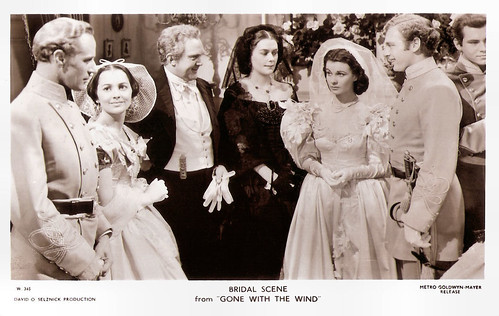
British postcard in the Picturegoer Series, London, no. W. 345. Photo: David O'Selznick Production / Metro-Goldwyn-Mayer. Publicity still for Gone with the Wind (Victor Fleming, 1939) with Leslie Howard, Olivia de Havilland and Vivien Leigh. Caption: Bridal scene from Gone with the Wind.
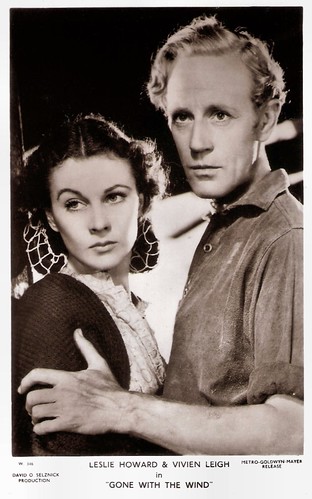
British postcard in the Picturegoer Series, London, no. W. 346. Photo: David O'Selznick Production / Metro-Goldwyn-Mayer. Publicity still for Gone with the Wind (Victor Fleming, 1939) with Leslie Howard and Vivien Leigh.

British postcard in the Picturegoer Series, London, no. W. 347. Photo: David O'Selznick Production / Metro-Goldwyn-Mayer. Publicity still for Gone with the Wind (Victor Fleming, 1939) with Vivien Leigh and Clark Gable.
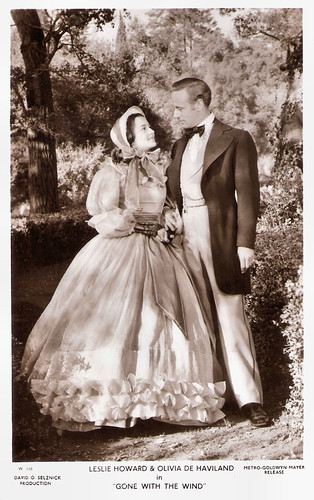
British postcard in the Picturegoer Series, London, no. W. 348. Photo: David O'Selznick Production / Metro-Goldwyn-Mayer. Publicity still for Gone with the Wind (Victor Fleming, 1939) with Leslie Howard and Olivia de Havilland.
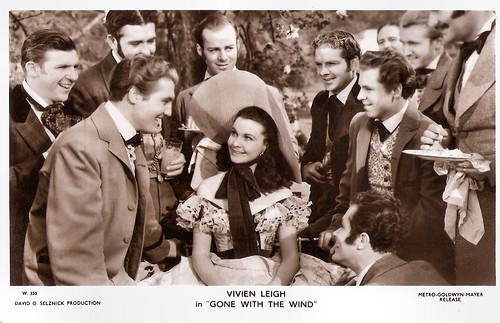
British postcard in the Picturegoer Series, London, no. W. 350. Photo: David O'Selznick Production / Metro-Goldwyn-Mayer. Publicity still for Gone with the Wind (Victor Fleming, 1939) with Vivien Leigh.
Production of Gone with the Wind (Victor Fleming, 1939) was difficult from the start. In July 1936 — a month after Margaret Mitchell published her novel —Selznick bought the rights for $50,000. Then, filming was delayed for two years because of David O'Selznick's determination to secure Clark Gable for the role of Rhett Butler, and the 'search for Scarlett'. Gable was under contract to MGM, which never loaned him to other studios. Eventually, O'Selznick struck a deal with MGM. His father-in-law, MGM chief Louis B. Mayer, offered in August 1938 to provide Gable and $1,250,000 for half of the film's budget but for a high price: Selznick would have to pay Gable's weekly salary, and half the profits would go to MGM while Loew's, Inc — MGM's parent company — would release the film.
The search for Scarlett has become a Hollywood legend. O'Selznick built publicity for the film by searching for the role and began a nationwide casting call that interviewed 1,400 unknowns. The effort cost $100,000 and was useless for the film, but created 'priceless' publicity. Many famous—or soon-to-be-famous—actresses were considered, but only thirty-one women were actually screen-tested for Scarlett including Jean Arthur, Tallulah Bankhead, Diana Barrymore, Joan Bennett, Paulette Goddard, Susan Hayward and Lana Turner. Gone With the Wind started filming without a Scarlett as the famous burning of Atlanta sequence was done first. While it was being done, David O. Selznick settled on a fairly unknown British actress, at least in the USA, Vivien Leigh. Her casting was announced on 13 January 1939.
The original screenplay was written by Sidney Howard. His first submission was far too long, and would have required at least six hours of film. The screenplay underwent many revisions by several writers in an attempt to get it down to a suitable length. The original director, George Cukor, was fired three weeks into filming and was replaced by Victor Fleming, who was directing The Wizard of Oz at the time. Fleming in turn would during filming be briefly replaced by Sam Wood while Fleming took some time off due to exhaustion. Fleming was dissatisfied with the script, so Selznick brought in famed writer Ben Hecht to rewrite the entire screenplay within five days. Hecht returned to Howard's original draft and by the end of the week had succeeded in revising the entire first half of the script. Selznick undertook rewriting the second half himself but fell behind schedule, so Howard returned to work on the script for one week, reworking several key scenes in part two. Despite the number of writers and changes, the final script was remarkably close to Howard's version.
About 300,000 people came out in Atlanta for the film's premiere at the Loew's Grand Theatre on 15 December 1939. Gone with the Wind received positive reviews upon its release, although some reviewers found it overlong. The casting was widely praised, and many reviewers found Leigh especially suited to her role as Scarlett. At the 12th Academy Awards, it received ten Academy Awards (eight competitive, two honorary) from thirteen nominations, including wins for Best Picture, Best Director (Victor Fleming), Best Adapted Screenplay (posthumously awarded to Sidney Howard), Best Actress (Vivien Leigh), and Best Supporting Actress (Hattie McDaniel). It set records for the total number of wins and nominations at the time.
Upon its release, Gone with the Wind broke attendance records everywhere. It became the highest-earning film made up to that point, and held the record for over a quarter of a century. When adjusted for monetary inflation, it is still the most successful film in box-office history. It was re-released periodically throughout the 20th century and became ingrained in popular culture. The film has been placed in the top ten of the American Film Institute's list of the top 100 American films since the list's inception in 1998. In 1989, the United States Library of Congress selected it for preservation in the National Film Registry.
Gone with the Wind is told from the point of view of the South, and it tends to portray slaves as a simpler people, who are being gently looked after by their white masters. More often than not the slaves are shown either as people of limited understanding or as straight up mentally handicapped. It usually isn't the focus of the film, but the story is about the Civil War so it's always on the background. Therefore, seeing the film today makes you feel uncomfortable sometimes, but on the other hand, the film also offers that rare chance to see lots of superb singing, dancing, and acting by African-Americans in a Hollywood production of the 1930s.
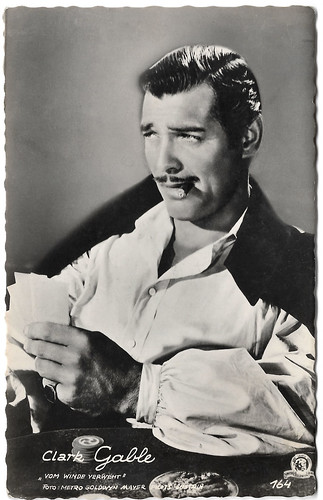
Austrian postcard by HDH Verlag, Wien (Vienna), no. 3394. Photo: Metro-Goldwyn-Mayer / Films Austria. Publicity still for Gone with the Wind (Victor Fleming, 1939) with Clark Gable.

German postcard by Rüdel-Verlag, Hamburg-Bergedorf, no. 732. Photo: Metro-Goldwyn-Mayer. Publicity still for Gone with the Wind (Victor Fleming, 1939) with Vivien Leigh.

Vintage card. Photo: Metro-Goldwyn-Mayer. Publicity still for Gone with the Wind (Victor Fleming, 1939) with Vivien Leigh.

Belgian postcard by Les Editions d'Art L.A.B., Bruxelles (Brussels), no. 1040. Photo: MGM (Metro-Goldwyn-Mayer). Publicity still for Gone With The Wind (1939) with Vivien Leigh.
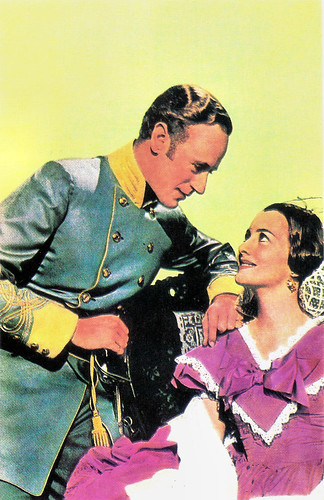
Romanian postcard by Casa Filmului Acin, no. 247. Photo: publicity still for Gone with the Wind (Victor Fleming, 1939) with Leslie Howard and Olivia de Havilland.

Romanian postcard by Casa Filmului Acin. Photo: MGM. Publicity still for Gone with the Wind (1939) with Vivien Leigh.

Romanian postcard by Casa Filmului Acin. Photo: MGM. Publicity still for Gone with the Wind (1939) with Clark Gable and Vivien Leigh.
Sources: Wikipedia and IMDb.

British postcard in the Picturegoer Series, London, no. W. 349. Photo: David O'Selznick Production / Metro-Goldwyn-Mayer. Publicity still for Gone with the Wind (Victor Fleming, 1939) with Vivien Leigh and Hattie McDaniel.

Italian postcard by Zincografica, Firenze. Photo: publicity still for Gone with the Wind (Victor Fleming, 1939) with Clark Gable and Vivien Leigh.

Dutch postcard by Filmfreak Productions / Painted Movies, no. FA 386. Illustration by Renato Casaro for Gone with the Wind (Victor Fleming, 1939).
An anti-hero who will remain in your memory forever
Gone with the Wind (1939) brought together the best people in Hollywood. The end result is a stunning film, which remains remarkably faithful to Margaret Mitchell's novel about the South, before and after the Civil War. The vision of David O. Selznick, the power behind bringing the novel to the screen, pays off handsomely. Credit must also be given to the director, Victor Fleming, and his vision, as well as the adaptation by Sydney Howard, who gave the right tone to the film. The gorgeous cinematography created by Ernest Haller gives us a vision of the gentle South before the war, and the Phoenix raising from the ashes of a burned Atlanta. The music of Max Steiner puts the right touch behind all that is seen in the film.
Crucial for the success of Gone with the Wind (1939) was the casting of British Vivien Leigh as southern belle Scarlett. Her beauty, her sense of timing, her intelligent approach to this role, makes this a hallmark performance. Leigh created an unforgettable, multi-layered character. Scarlett is not a pleasant person, not at all. she can be whiny, needy and mousy. She's also scheming, manipulative, almost purely after her own interest. And Scarlett sure does not take a no for an answer. At times, you literally despise her, but then in the next breath she shows strength and wisdom. Scarlett goes from riches to rags, back to riches again and in the process finds an inner strength she didn't know she possessed. Classic is the scene in which she swears that she and hers shall never suffer again. The public understands where she is coming from and admires her. Scarlett is not immune to the suffering of others either, she is loyal to those she considers hers and her sheer willpower and force of personality are impressive and make her an anti-hero, who will remain in your memory forever.
Scarlett is beautifully set up and contrasted by those around her. There is an incredible unmatched chemistry between the two romantic leads. Clark Gable as the irrepressible Captain Rhett Butler has this air of over-confidence. No one else comes to mind for playing him with the passion he projects throughout the film. Butler is the macho party man with nothing holding him down including political ties. Captain Butler is torn between his loyalty to the cause of the South and his sense of decency. However, his reputation as a drunkard and a rich bachelor suits him fine. When Scarlett comes into his life, he falls hopelessly in love with the most unlikely girl and she plagues him for years. His love for Scarlett, the woman he knows is in love with a dream, speaks eloquently for itself. In the last half hour of the film when he's hit with unbelievable tragedy and he edges to the point of madness, Gable reaches dimensions he never did before or subsequently. Throughout the film, he looks incredible handsome and relaxed, and Gable proves in the film why he was one of the biggest stars of Hollywood's Golden Age.
The supporting cast is huge and does an incredible job. Leslie Howard is also very good as Scarlett's love interest for years and years, wealthy plantation owner Ashley Wilkes. Ashley is a strong character. He's the one that reluctantly enlists in the Confederate Army while the cynical Rhett Butler makes some big bucks as a blockade runner. Howard gives a perfect balance to the man in love with his wife, while Scarlett keeps tempting him. Olivia de Havilland plays the loving and kind Melanie Wilkes, who marries Ashley away from Scarlett. Melanie is the counterpoint to Scarlett, an incredibly kind and decent soul who can't see bad in anyone. Melanie remains loyal to the woman that does everything to undermine her marriage to Ashley. Thanks to the talent of Olivia de Havilland, Melanie never becomes a maudlin character. For her role, de Havilland got her first Oscar nomination in the Supporting Actress category.
Other actors in the cast include Harry Davenport, Thomas Mitchell, Barbara O'Neil, Butterfly McQueen, George Reeves (the future Superman), and Richard Farnsworth. My favourite however is Hattie McDaniel, a natural actress and a joy to watch. She is just wonderful as 'Mammy' the beloved house servant. She was the first African American actor to be nominated for an Academy Award, and it's still remarkable that McDaniel won an Oscar in a land that was so bigoted at the time. Hattie McDaniel was absent from the premiere of the film, as she and the other black cast members were prevented from attending the premiere due to Georgia's Jim Crow laws, which kept them from sitting with their white colleagues. Upon learning that McDaniel had been barred from the premiere, Clark Gable threatened to boycott the event, but McDaniel convinced him to attend.

British postcard in the Picturegoer Series, London, no. W. 345. Photo: David O'Selznick Production / Metro-Goldwyn-Mayer. Publicity still for Gone with the Wind (Victor Fleming, 1939) with Leslie Howard, Olivia de Havilland and Vivien Leigh. Caption: Bridal scene from Gone with the Wind.

British postcard in the Picturegoer Series, London, no. W. 346. Photo: David O'Selznick Production / Metro-Goldwyn-Mayer. Publicity still for Gone with the Wind (Victor Fleming, 1939) with Leslie Howard and Vivien Leigh.

British postcard in the Picturegoer Series, London, no. W. 347. Photo: David O'Selznick Production / Metro-Goldwyn-Mayer. Publicity still for Gone with the Wind (Victor Fleming, 1939) with Vivien Leigh and Clark Gable.

British postcard in the Picturegoer Series, London, no. W. 348. Photo: David O'Selznick Production / Metro-Goldwyn-Mayer. Publicity still for Gone with the Wind (Victor Fleming, 1939) with Leslie Howard and Olivia de Havilland.

British postcard in the Picturegoer Series, London, no. W. 350. Photo: David O'Selznick Production / Metro-Goldwyn-Mayer. Publicity still for Gone with the Wind (Victor Fleming, 1939) with Vivien Leigh.
The most successful film in box-office history
Production of Gone with the Wind (Victor Fleming, 1939) was difficult from the start. In July 1936 — a month after Margaret Mitchell published her novel —Selznick bought the rights for $50,000. Then, filming was delayed for two years because of David O'Selznick's determination to secure Clark Gable for the role of Rhett Butler, and the 'search for Scarlett'. Gable was under contract to MGM, which never loaned him to other studios. Eventually, O'Selznick struck a deal with MGM. His father-in-law, MGM chief Louis B. Mayer, offered in August 1938 to provide Gable and $1,250,000 for half of the film's budget but for a high price: Selznick would have to pay Gable's weekly salary, and half the profits would go to MGM while Loew's, Inc — MGM's parent company — would release the film.
The search for Scarlett has become a Hollywood legend. O'Selznick built publicity for the film by searching for the role and began a nationwide casting call that interviewed 1,400 unknowns. The effort cost $100,000 and was useless for the film, but created 'priceless' publicity. Many famous—or soon-to-be-famous—actresses were considered, but only thirty-one women were actually screen-tested for Scarlett including Jean Arthur, Tallulah Bankhead, Diana Barrymore, Joan Bennett, Paulette Goddard, Susan Hayward and Lana Turner. Gone With the Wind started filming without a Scarlett as the famous burning of Atlanta sequence was done first. While it was being done, David O. Selznick settled on a fairly unknown British actress, at least in the USA, Vivien Leigh. Her casting was announced on 13 January 1939.
The original screenplay was written by Sidney Howard. His first submission was far too long, and would have required at least six hours of film. The screenplay underwent many revisions by several writers in an attempt to get it down to a suitable length. The original director, George Cukor, was fired three weeks into filming and was replaced by Victor Fleming, who was directing The Wizard of Oz at the time. Fleming in turn would during filming be briefly replaced by Sam Wood while Fleming took some time off due to exhaustion. Fleming was dissatisfied with the script, so Selznick brought in famed writer Ben Hecht to rewrite the entire screenplay within five days. Hecht returned to Howard's original draft and by the end of the week had succeeded in revising the entire first half of the script. Selznick undertook rewriting the second half himself but fell behind schedule, so Howard returned to work on the script for one week, reworking several key scenes in part two. Despite the number of writers and changes, the final script was remarkably close to Howard's version.
About 300,000 people came out in Atlanta for the film's premiere at the Loew's Grand Theatre on 15 December 1939. Gone with the Wind received positive reviews upon its release, although some reviewers found it overlong. The casting was widely praised, and many reviewers found Leigh especially suited to her role as Scarlett. At the 12th Academy Awards, it received ten Academy Awards (eight competitive, two honorary) from thirteen nominations, including wins for Best Picture, Best Director (Victor Fleming), Best Adapted Screenplay (posthumously awarded to Sidney Howard), Best Actress (Vivien Leigh), and Best Supporting Actress (Hattie McDaniel). It set records for the total number of wins and nominations at the time.
Upon its release, Gone with the Wind broke attendance records everywhere. It became the highest-earning film made up to that point, and held the record for over a quarter of a century. When adjusted for monetary inflation, it is still the most successful film in box-office history. It was re-released periodically throughout the 20th century and became ingrained in popular culture. The film has been placed in the top ten of the American Film Institute's list of the top 100 American films since the list's inception in 1998. In 1989, the United States Library of Congress selected it for preservation in the National Film Registry.
Gone with the Wind is told from the point of view of the South, and it tends to portray slaves as a simpler people, who are being gently looked after by their white masters. More often than not the slaves are shown either as people of limited understanding or as straight up mentally handicapped. It usually isn't the focus of the film, but the story is about the Civil War so it's always on the background. Therefore, seeing the film today makes you feel uncomfortable sometimes, but on the other hand, the film also offers that rare chance to see lots of superb singing, dancing, and acting by African-Americans in a Hollywood production of the 1930s.

Austrian postcard by HDH Verlag, Wien (Vienna), no. 3394. Photo: Metro-Goldwyn-Mayer / Films Austria. Publicity still for Gone with the Wind (Victor Fleming, 1939) with Clark Gable.

German postcard by Rüdel-Verlag, Hamburg-Bergedorf, no. 732. Photo: Metro-Goldwyn-Mayer. Publicity still for Gone with the Wind (Victor Fleming, 1939) with Vivien Leigh.

Vintage card. Photo: Metro-Goldwyn-Mayer. Publicity still for Gone with the Wind (Victor Fleming, 1939) with Vivien Leigh.

Belgian postcard by Les Editions d'Art L.A.B., Bruxelles (Brussels), no. 1040. Photo: MGM (Metro-Goldwyn-Mayer). Publicity still for Gone With The Wind (1939) with Vivien Leigh.

Romanian postcard by Casa Filmului Acin, no. 247. Photo: publicity still for Gone with the Wind (Victor Fleming, 1939) with Leslie Howard and Olivia de Havilland.

Romanian postcard by Casa Filmului Acin. Photo: MGM. Publicity still for Gone with the Wind (1939) with Vivien Leigh.

Romanian postcard by Casa Filmului Acin. Photo: MGM. Publicity still for Gone with the Wind (1939) with Clark Gable and Vivien Leigh.
Sources: Wikipedia and IMDb.
No comments:
Post a Comment